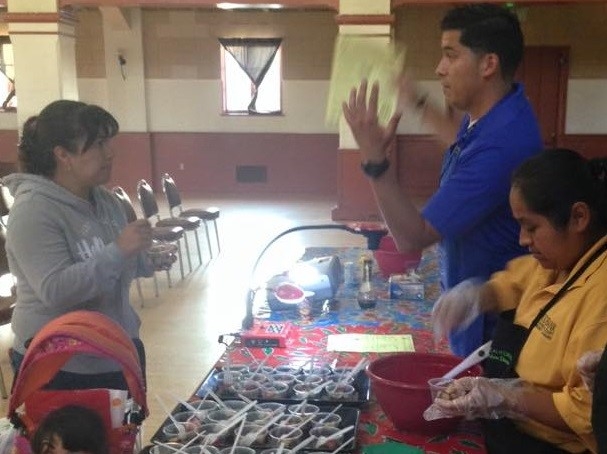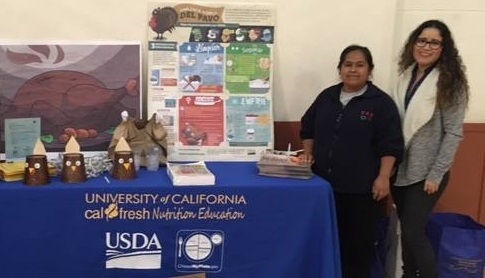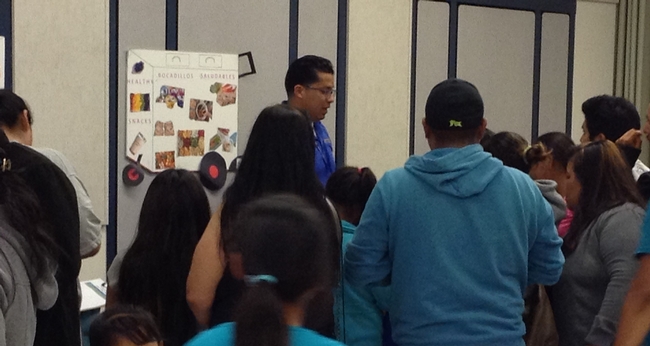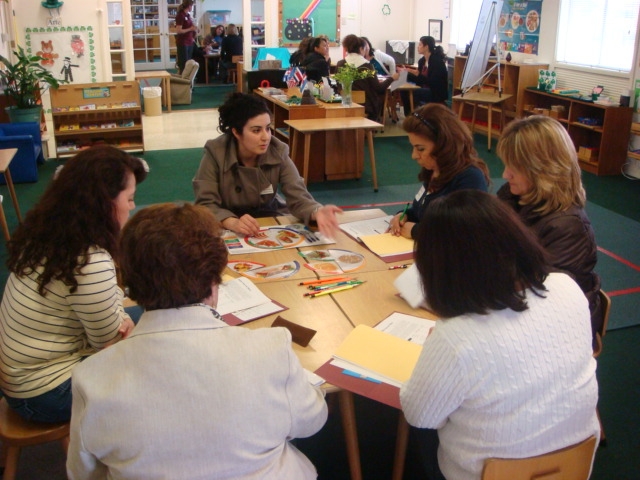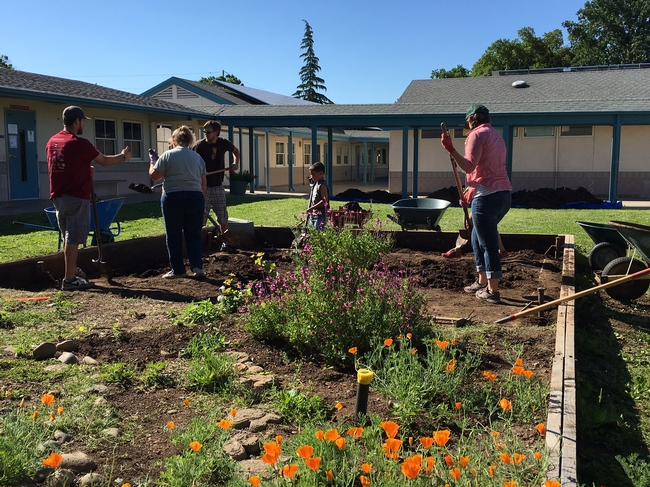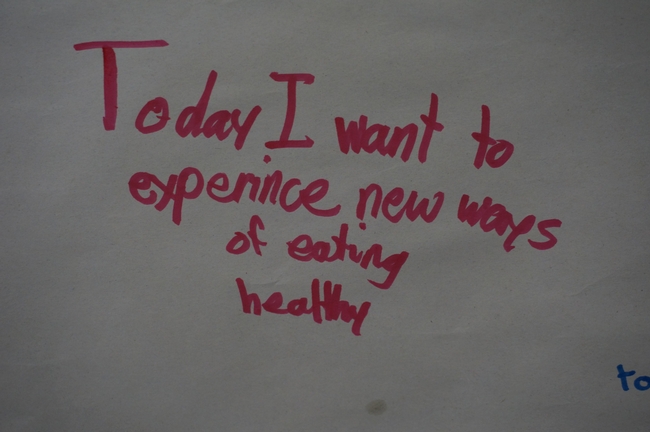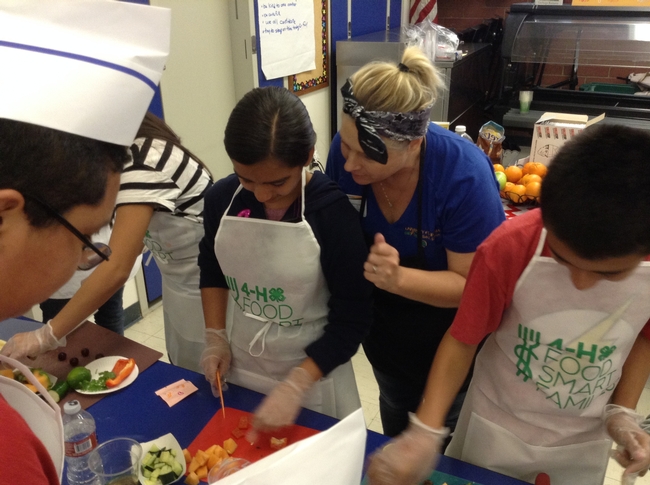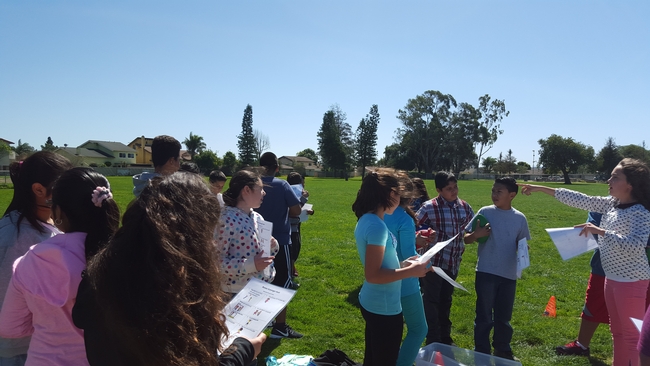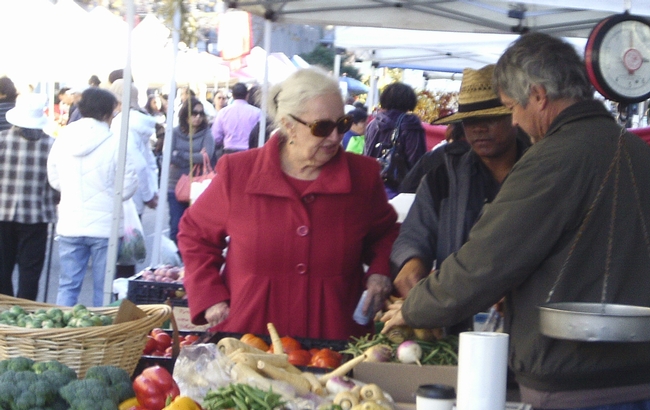Posts Tagged: UC CalFresh Nutrition Education Program
With nutrition education, a conversation may be more fruitful than a lecture
How do we support low-income Latino families with appropriate nutrition education that makes a difference in their lives? This was the question staff with the UC CalFresh Nutrition Education Program in San Luis Obispo and Santa Barbara counties were asking ourselves as we prepared for a monthly presentation at the THRIVE Healthy School Pantry in Santa Maria, California.
While many nutrition education programs work with local food banks to provide food demonstrations and nutrition information at supplemental food distribution sites, often, these classes can feel rushed. People are likely hurrying to pick up their food and so there is little time for more than just one-way communication where the educator provides the information and participants listen. Other times families may feel obligated to stay for the nutrition lesson in order to get their bag of food for their families.
This was the experience of our UC CalFresh Nutrition Educators delivering presentations and recipe demonstrations at the Healthy School Pantry food distribution. The Healthy School Pantry is a monthly food distribution focused on increasing food security and providing a strong social network for families to access a wide variety of community resources in English and Spanish.
When our nutrition education team started working at the Healthy School Pantry, the set-up was similar to a formal classroom environment where there was a teacher and students. The students (in this case, parents and families) would sit in rows, while the nutrition educator stood up front with a projector and microphone providing nutrition messages and a recipe demonstration using food from the pantry. We would include skills for preparing a recipe, and offer food samples and practical tips related to USDA's MyPlate.
After a few of these formal presentations, we began to notice that many parents were not interacting. We would ask for questions or suggestions on how participants could use this information or recipe, and most would respond with silence or politely, “todo está bien, gracias” [“everything is good, thanks”]. We also noticed other families would try to get past our table without making eye contact in order to leave. It became apparent that the families, for various personal or cultural reasons, did not feel comfortable participating and interacting in this formal class setting. Others just did not want to sit and listen for 15 to 30 minutes if they weren't sure that the information was going to be relevant to them.
Taking this into account, we decided to modify our approach. First, we got rid of the microphone and projector and moved our table into a high traffic area more integrated with the other community resources. Next, we changed our presentations to be more participatory and conversational. We set up our table with a colorful display and often a food sample, and then we walked around to the front of the table where we could greet and approach the families without a barrier. At one recent event, we brought an activity wheel and some basic physical activity equipment like jump ropes and stretchy bands. Parents walked right up and started to spin the wheel. When it landed on an exercise they would grab the equipment and start doing the activity and asking for tips. We were so surprised that they wanted to actually do the exercise right then and there and were really interested in talking to us about how they could get more physical activity in their busy lives. At one point we had a long line of parents waiting.
With these small changes, parents are provided more individual attention and an opportunity to have a conversation with the educator rather than feeling like they are students in a classroom. We are able to have more meaningful conversations and the parents are the ones approaching us and asking, “What recipe are you preparing today?” Parents are initiating the conversations and once we engage with them, they have many more questions about the ingredients, where to get them and the dialogue continues in a natural way that is meaningful and relevant to their lives. We are also able to clear up some misconceptions they may have. For example, we have heard many parents say they think that canned or frozen fruits are not healthy. Once we have their trust we are able to clear up the misinformation and let them know that canned and frozen produce can be an economical way to get more fruits and vegetables in their diet and, as long as there isn't added salt or sugar, can be just as healthy as fresh produce.
Within these conversations we take the opportunity to provide nutrition messages and tips, but we also have the opportunity to hear the parents' perspectives and comments. For example, one participant commented on a recipe they were demonstrating saying, “I really like the bean and garbanzo salad because it's nutritious, it has iron, vitamins and it is really easy to make.”
For our larger nutrition education program, this method has brought about additional benefits, including the opportunity to build stronger relationships with parents in the community and to talk to them about what our program is doing with their children during the school day. One mother who had approached our table several times in the past told us, "For me and my family, we have changed a lot about how we eat. We eat healthier and cheaper and we spend less on buying junk food. My children like what they have been taught in their classes by your program. That's why I like it because my children no longer like to eat things that are not healthy.”
Through these conversations, we see that families are leaving our table more informed and are more willing to seek out and approach our table the following month. The level and quality of interaction has increased and we are able to see and hear about the impact of our work and modify or change approaches based on the suggestions from the families.
We will continue with this successful education delivery model because we have seen and heard the satisfaction of the families and have received a lot of great feedback from parents. These small successes that are revealed to us through mutually respectful conversations keep us motivated to continue to provide services and promote a healthier community in a way that respects and values the experiences and knowledge that our families share.
The power of listening: Working for positive change in SNAP-Ed communities
Change takes time. There are frequently obstacles. But when it occurs, it can be satisfying.
This year, over 1,000 participant quotes from adults in the UC CalFresh Nutrition Education Program chart a course for change. In the food eaten, beverages consumed, or daily exercises undertaken, participants describe a desire to take a new approach, or be more conscious of the little daily decisions that can make all the difference in health.
In 2015, UC CalFresh programs were delivered in 891 sites. The majority of sites were education-oriented, with 78 percent being either public schools, preschools, adult education, or Head Start programs.
“This class changed eating habits for my family and friends." - Eating Smart Being Active class, Fresno County
“This class was very informative and it gave me tips and ideas on how to stay healthy, how to be active with our children and also great recipes! I enjoyed the class and will use their tips and ideas when thinking about my diet.” - Eating Smart Being Active class, Fresno County
Many quotes express thanks for a program that offers evidence-based curricula to help improve food resource management – budgeting for healthy food while on the Supplemental Nutrition Assistance Program (SNAP - formerly food stamps) or offer recipes that are tasty on a limited budget. Some quotes reflect on what was learned, and how to continue making decisions that “stay the course” in healthy food selection and preparation. And then, there are those that thank dedicated educators, such as this one:
“My first time here at the nutrition class was April 21. All of the information taught by Julie was important and I learned about eating better, making simple quick healthy meals. My granddaughter walked into the class for the last 10 minutes. She tasted some of the meal and she said, 'Yum -- very good. Grandma can we take some home.' I told her we had the recipe and she asked to go buy the ingredients and make some at home because it was very good and she wanted to eat more. She helped me buy ingredients and helped me prepare the meal. She ate 2 bowls …She wants to try other healthy meals. Thank you for providing this nutrition program to share with us!” - Plan Shop Save and Cook class, Kings County
Occasionally, there are inspirational stories that touch our hearts and make us re-dedicate ourselves each day to our work:
“My son is a kindergartener. He is also autistic with many sensory issues! He only eats certain things (like chips, pop tarts, canned soup and raviolis). The UC CalFresh educator, Mrs. Carter, came in to do a nutrition taste test with the students today and, to my surprise, my son ate edamame willingly. He said it was awesome! For me, this is a big milestone! It could be the start of trying new foods! I love this program… It's great for all kids!” - Healthy Happy Me class, Placer County
Moving from individual education to policy, systems and environmental change agents
In the past few years, UC CalFresh has increasingly worked on developing programs that have policy, systems and environmental change approaches. However, the stories told by participants illustrate the importance of building our programs from a foundation of direct education.
In this effort, UC CalFresh uses a “school as the hub” model in communities. Schools are seen as pivotal arenas for nutrition education that can also influence broader policy, systems, and environmental change. Through classroom nutrition education with students, and after-school programs for their families, schools generate the potential to reach different age groups in the community effectively.
A school is a powerful environment for learning, growth and community engagement - from school gardens to work with food service directors creating nutritious meals and enhancing the cafeteria environment, to playground activities with stenciling and murals reflecting healthy choices. Opportunities abound to generate change in perspectives on food choices, physical activity, and healthy living.
Assisting communities to build capacity for sustainable change
As we work with communities to build capacity in the areas described above, over time, a transition has the opportunity to take effect whereby local leaders - principals, teachers, parents, grandparents and students - motivated by the desire to embrace long-lasting healthy changes in their family and community - act as role models and change agents. This fundamental shift moves institutional initiative and strategies into “community-based systems change.” And the seeds of this change began with a lesson, a child, a parent, an educator … a simple quote.
This story en español.
Inspiring youth leaders to cultivate health
What are sixth-graders interested in these days? “Cooking!” “Growing food!” “Learning how to be healthier.” “Exercising.” “Meeting new friends!” These enthusiastic answers came from sixth-grade student leaders in Santa Maria, Calif., when asked by educators from the UC Cooperative Extension Youth, Families and Communities program in San Luis Obispo and Santa Barbara counties.
Through an integrated youth-focused healthy living project, called Food Smart Families, funded by National 4-H, the UC ANR 4-H Youth Development Program, and the UC CalFresh Nutrition Education program, 32 fourth- through sixth-grade student leaders were brought together from three schools in Santa Maria, Calif., for a full-day educational retreat that focused on engaging youth to explore their healthy lifestyle interests and see themselves as leaders.
Throughout the day, student leaders experienced physical activity games, learned cooking skills, participated in garden-based learning, and developed their presentation skills. They focused on skill development, as well as transference so that the student leaders could take these activities into their own schools to encourage and teach their peers. For example, the fun physical activity breaks that were incorporated throughout the day modeled games where no one is “out” or excluded, while moving enough to get heart rates up.
After the retreat, the student leaders brought these activities to their own schools, leading their peers in the games during lunch and recess breaks. During the retreat, the student leaders also got to practice knife safety skills while chopping produce to prepare their own veggie pita pockets and fruit salads. With these skills, the student leaders offered food demonstrations and nutrition lessons to their peers during the following weeks.
In the garden, student leaders learned the basics of growing food and how to lead a garden lesson. Students discussed garden tools and how to use them safely, then planted their own seeds to take home. The garden session ended with a gleaning of the school citrus orchard where students laughed and enjoyed the fresh air and fresh fruits growing around them. In their own school gardens, the student leaders have offered lessons and tastings to their peers.
The retreat culminated with youth presentations. The student leaders worked in teams with students from different schools to generate ideas and artwork for the Student Nutrition Advisory Council (SNAC) logo and t-shirt design. They presented their concepts to the larger group, practicing their presentation skills. The student leaders voted on the designs and a winner was selected to be featured on a t-shirt for SNAC leaders at each of the three schools. The students leaders proudly wear their shirts as they lead healthy living education, advocacy and engagement activities.
By the end of the retreat, the student leaders were excited to take the information and skills back to their schools and start leading. Students shared their plans to help other students be more active during recess, be healthy, and help other kids be healthier too.
“This was the best day I have ever had,” said one of the students.
Since the retreat, the student-led initiatives have been numerous and continually evolving. The sixth-graders have encouraged and trained younger students to become their successors as they move onto junior high. Several students co-authored and starred in a video production called “Get to Know Your Salad Bar.” With educator encouragement, the student leaders developed a script to motivate their peers to try out the salad bar by mixing fruit into their salad to make it sweet or putting lettuce and tomato on your hamburger to make it juicy and crunchy. Beyond leading in their own schools, the student leaders have been working to help their entire community. Many of the student leaders helped organize and conduct game-style nutrition activities at a local food pantry distribution to teach families about shopping for healthy foods on a limited budget. Other student leaders provided education and training to students at neighboring schools, encouraging them to become leaders as well.
Through the efforts of the Food Smart Families program, the Youth, Families, & Communities program in San Luis Obispo & Santa Barbara counties merged the strengths of the UC CalFresh Nutrition Education program and the UC ANR 4-H Youth Development program to provide new opportunities and experiences for students in this community. With interested and caring adults, these student leaders learned to share their passions for cooking, gardening, and healthy lifestyle with their peers at school and others in their community. The rewards for the school, community and adult allies continue to expand as these inspired student leaders, with strong mentorship and support, take on some of the biggest challenges facing our society and world.
Community Produce Stand opens March 2 in East Oakland
To improve access to fresh produce for low-income seniors who live in a food desert in East Oakland, UC ANR Cooperative Extension in Alameda County, in partnership with Oakland Housing Authority and Mandela Market Place, will be opening a Community Produce Stand.
The Community Produce Stand will be open on the first Wednesday of every month, from 2 p.m. to 4 p.m., at 6401 Fenham Street in Oakland.
The produce stand will be located in the gazebo at Palo Vista Gardens, a low-income senior housing complex, and available to neighboring residents as well as people in two other Oakland Housing Authority sites, reaching more than 950 Oakland Housing Authority residents.
At the grand opening from 2 p.m. to 4 p.m. on Wednesday, March 2, a health fair will feature UC CalFresh representatives sharing healthy eating tips and recipes. La Clínica Dental, City Slicker Farms, Fresh Approach, Alameda County Community Food Bank and California Telephone Access Program will also participate and share resources.
The Community Produce Stand will accept CalFresh Electronic Benefit Transfer cards, said Tuline Baykal, UC CalFresh supervisor with UC Agriculture and Natural Resources in Alameda County. “Being able to buy fresh, affordable produce with EBT is important,” Baykal said, “because seniors and other residents may be tempted to opt for less healthy options to stretch their food dollars.”
Food deserts lack vendors that carry fresh fruit, vegetables and other healthful whole foods, and are usually found in poor parts of town. The supermarket closest to Palo Vista Gardens is 1.5 miles away. Between the housing site and the nearest store are half a dozen fast food restaurants and three liquor stores. Six convenience stores are in the vicinity, but they stock mostly processed, sugary and fat-laden foods.
“Low-income seniors often experience multiple barriers to healthful foods,” said Jaime Manalang, resident services coordinator with Oakland Housing Authority. “The lack of grocery stores and farmers' markets within close proximity to home, limited transportation options and their own physical mobility restrictions limit seniors' access to food, especially fresh fruits and vegetables.”
Healthful nutrition is critical for reducing the risk of disease and managing chronic health conditions, and is an important factor to living independently.
New school meals provision gives kids more access to healthy food
“This initiative reduces hunger among children in high-poverty areas, and ensures students have access to the healthy food they need to succeed in school,” USDA Under Secretary Kevin Concannon said during Tuesday's visit to Edison Computech Middle School in Fresno.
“About 20 percent of U.S. households with children were food insecure at some time in 2013 – meaning they had trouble affording enough food to eat,” said Lorrene Ritchie, director of UC Nutrition Policy Institute.
The new provision allows school districts to serve all of their students at no charge to the students, reducing the districts' paperwork for the school meal program. It also removes the stigma that deterred some students from accepting the needed nourishment.
“One of the largest and most accessible means to reduce food insecurity in children and improve their diet is the federal school lunch and breakfast programs,” said Ritchie. “Research has shown that school meals are healthier than most meals that students get elsewhere. For these reasons, we are highly supportive of the Community Eligibility Provision, which makes it easier for the kids who need it the most to have access to healthy meals at school.”
“It is wonderful to see that Fresno Unified School District has jumped on the brand new opportunity that the Community Eligibility Provision offers to bring nutritious meals and snacks to all of its students without charge,” Kenneth Hecht, director of policy for the UC Nutrition Policy Institute.
“More than four out of five families of Fresno Unified School District's 75,000 students have such low-incomes that they qualify for free or reduced-price meals,” Hecht said. “Many students' families are not English-language households, and the school district has been struggling — effectively — to improve its dropout and graduation rates. Free school meals are a major element in the district's successful effort to improve student success: nutritious free meals bring children to school, contribute to their health and academic performance and let families spend the money they save when their children can eat at school to improve the nutrition quality of the meals that are prepared at home.”
In addition to being able to serve more students, Fresno Unified School District's seven-year-old, state-of-the-art kitchen enables school chefs to prepare all meals and snacks within the district, according to Hecht. “This means food can be freshly prepared, without relying on preprocessed foods that often include fats, sugars and other unhealthy additives that contribute to childhood obesity,” he said, adding, “Children in Fresno County experience a more than 40 percent rate of overweight and obesity.”
“Not surprisingly food insecurity can result in lower diet quality,” said Ritchie. “For example, in a new study to be published in the Journal of Nutrition, we found that higher levels of food insecurity among children was related to increased consumption of energy, fat and sugar, and a lower intake of vegetables. Food insecurity can also have negative behavioral and cognitive effects.”
During Concannon's visit to Computech, members of the UC CalFresh nutrition education team met and got a photo of the USDA under secretary touring the kitchen.
“We were present due to UC CalFresh's close partnership with the district,” said Shelby MacNab, UC Cooperative Extension nutrition program manager in Fresno County. “We teach nutrition and are leading the Smarter Lunchrooms movement (SLM). Computech was our pilot site and the district was thrilled with the outcome. The undersecretary said SLM was music to his ears.”

